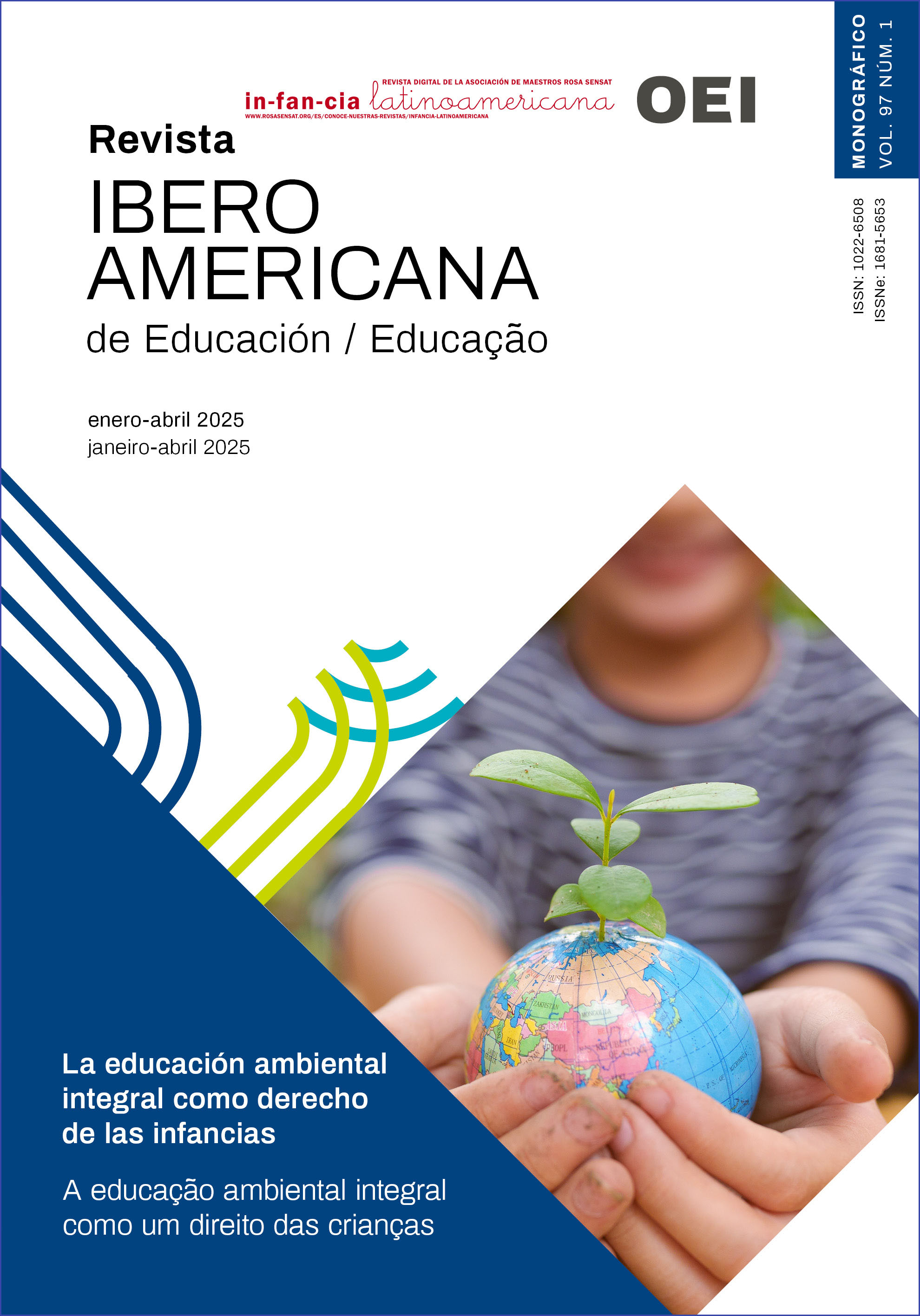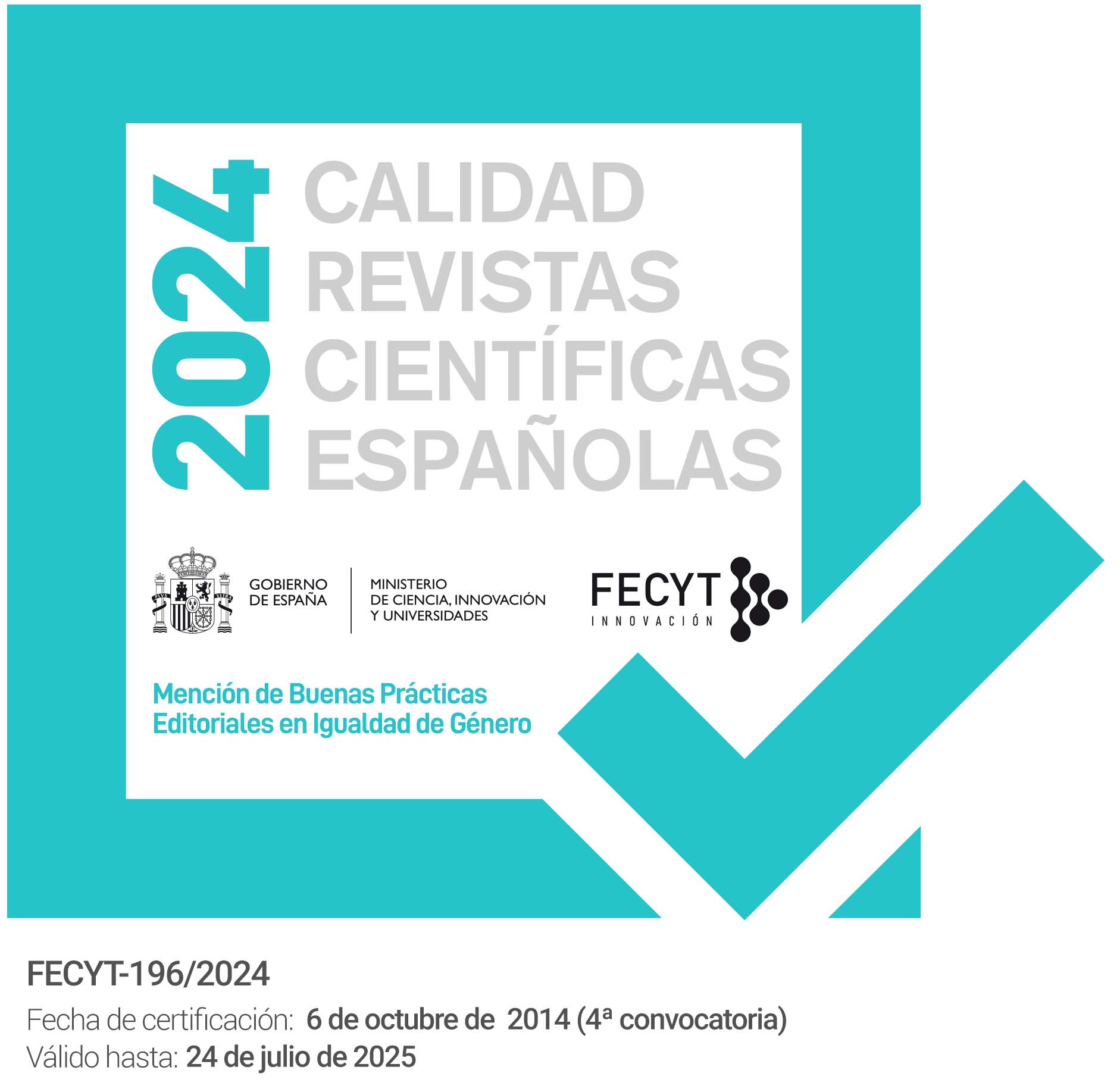Interculturalidad sin fronteras: hermenéutica del concepto en proyectos de aprendizaje desarrollados en la Raya luso-española
DOI:
https://doi.org/10.35362/rie9716644Palabras clave:
Interculturalidad, Frontera, Proyectos de Aprendizaje, EducaciónResumen
El concepto de interculturalidad adquiere comprensión variable en función de los marcos teóricos movilizados y los contextos sociales y geopolíticos en los que se aplica. Este estudio pretende comprender su hermenéutica en los proyectos de aprendizaje desarrollados en el curso 2021/2022 del “Proyecto Escuelas Bilingües e Interculturales de Frontera”. Implementados en clases de 1.º a 6.º grado en escuelas en la raya luso-española, los proyectos fueron analizados considerando las categorías: (1) conocimientos sobre elementos culturales transfronterizos y (2) dinámicas educativas interculturales. Los resultados muestran que su mayoría prioriza conocimientos sobre cultura regional y nacional objetiva, con excepción de uno, que adopta una perspectiva de ciudadanía global. Estos conocimientos asumieron forma práctica mediante dinámicas interculturales performativas, recurriendo a multiliteracies; y también relacionales, visibles sobre todo en encuentros transfronterizos y en la implicación de los stakeholders en un paradigma de escuela como ecosistema.
Descargas
Citas
Anderson, J., & Macleroy, V. (2017). Connecting worlds: interculturality, identity and multilingual digital stories in the making. Language and Intercultural Communication, 17(4), 494-517. https://doi.org/10.1080/14708477.2017.1375592 DOI: https://doi.org/10.1080/14708477.2017.1375592
Araújo e Sá, M. H., Matesanz, M., & Martins, V. (2022) Guião para a construção do projeto de aprendizagem numa perspetiva de investigação-ação e em rede. Universidade de Aveiro e Universidad Complutense de Madrid.
Bakhtin, M. (1981). The dialogic imagination: Four essays. (C. Emerson & M. Holquist, trad.). University of Texas Press.
Bardin, L. (2009). Análise de conteúdo. (L. Reto & A. Pinheiro, trad.). Edições 70.
Beacco, J. C., Byram, M., Cavalli, M., Coste, D., Cuenat, M. E., Goullier, F., & Panthier, J. (2016). Guide for the development and implementation of curricula for plurilingual and intercultural education. Council of Europe. https://doi.org/10.3917/europ.beac.2016.02 DOI: https://doi.org/10.3917/europ.beac.2016.02
Bennett, M. (2013). Basic concepts of intercultural communication: Paradigms, principles & practices (2.ª ed.). Intercultural Press. (Original publicado em 1998).
Benson, P. (2021). Language Learning Environments: Spatial Perspectives on SLA. Multilingual Matters. DOI: https://doi.org/10.21832/9781788924917
Bhabha, H. (1994). The Location of Culture. Routledge.
Bosio, E. & Torres, C. A. (2019). Global citizenship education: An educational theory of the common good? A conversation with Carlos Alberto Torres. Policy Futures in Education, 17(6), 745–760. https://doi.org/10.1177/1478210319825517 DOI: https://doi.org/10.1177/1478210319825517
Brito de Arruda, G., & Pereira Tamwing, M. (2023). O caso do portunhol: uma língua de fronteira(s). Revista Geadel, 4(1), 145–157. https://doi.org/10.29327/269116.4.1-11 DOI: https://doi.org/10.29327/269116.4.1-11
Bruner, J. S. (1990). Acts of meaning. Harvard University Press.
Byram, M. (1997). Teaching and Assessing Intercultural Communicative Competence. Multilingual Matters.
Candelier, M., Camilleri-Grima, A., Castellotti, V., Pietro, J., Lörinez, I., Meissner, F., Schröeder-Sura, A., Noguerol, A., & Molinié, M. (2010). Framework of reference for pluralistic approaches to languages and cultures. Council of Europe. https://lc.cx/1Ev8Hz
Carinhas, R., Araújo e Sá, M. H., & Moore, D. (2020). Mi calle favorita: a reconstrução multimodal da paisagem da Ciudad Vieja de Montevideu num projeto plurilíngue entre a escola, os museus e as famílias. Domínios de Lingu@gem, 14(4), 1059–1086. https://doi.org/10.14393/DL44-v14n4a2020-2 DOI: https://doi.org/10.14393/DL44-v14n4a2020-2
Cope, B., & Kalantzis, M. (2020). Adding Sense: Context and Interest in a Grammar of Multimodal Meaning. Cambridge University Press. DOI: https://doi.org/10.1017/9781108862059
Council of Europe (2020). Common European Framework of Reference for languages: learning, teaching, assessment (Companion Volume). https://lc.cx/c6LR1h
Cummins, J., & Early, M. (Ed.). (2011). Identity texts: the collaborative creation of power in multilingual schools. Trentham Books.
Dervin, F. (2021). Characterizing interculturality. In F. Dervin & A. Simpson (Eds.), Interculturality and the Political within Education (1.ª ed., pp. 6-22). Routledge focus. DOI: https://doi.org/10.4324/9780429471155-2
Fantini, A. (2009). Assessing intercultural competence: Issues and tools. In D. K. Deardorff (Ed.), The SAGE handbook of intercultural competence, pp. 456–476. Sage. DOI: https://doi.org/10.4135/9781071872987.n27
Ferri, G. (2018). Intercultural Communication: Critical Approaches and Future Challenges. Palgrave Macmillan. DOI: https://doi.org/10.1007/978-3-319-73918-2_1
Foucault, M. (1979). Microfísica do poder. Graal.
Freire, P. (1970). Pedagogia do oprimido. Paz e Terra. https://lc.cx/oaH7_4
Garbarino, S., & Leone, P. (2020). Innovation dans un projet de télécollaboration orale em intercompréhension: bilan et perspectives du projet IOTT. Open Edition Journals: Alsic, 23(2), 1-20. https://doi.org/10.4000/alsic.4790 DOI: https://doi.org/10.4000/alsic.4790
Gobierno de Portugal & Gobierno de España (2020, septiembre). Estrategia Común de Desarrollo Transfronterizo. https://lc.cx/v_C5u0
Gumperz, J. & Hymes, D. (1972). Directions in sociolinguistics: the ethnography of communication. Holt, Rinehart and Winston.
Hall, E. (1975). The silent language. Doubleday & Company. https://lc.cx/3GqS5Z
Hamman, P. (2019). Frontières fluviales ou espaces-frontières? Regards sociologiques, Cahiers du plurilinguisme européen, 11. https://www.ouvroir.fr/cpe/index.php?id=1124 DOI: https://doi.org/10.57086/cpe.1124
Hann, C. (2016). A concept of Eurasia. Current Anthropology, 57(1), 1–27. https://doi.org/10.1086/684625 DOI: https://doi.org/10.1086/684625
Hanzi, Z. (2019). Avaliação de Competência Intercultural: Estudantes Universitários Chineses de PLE. [Tese de doutoramento, Faculdade de Letras da Universidade de Lisboa]. https://lc.cx/kBz5ED
Hegel, F. (1992). Fenomenologia do espírito (2.ª ed.). (P. Meneses, trad.). Petrópolis. (Original publicado em 1807).
Hoff, H. (2020). The Evolution of Intercultural Communicative Competence: Conceptualizations, Critiques and Consequences for 21st Century Classroom Practice. Intercultural Communication Education 3(2), 55-74. 10.29140/ice.v3n2.264 DOI: https://doi.org/10.29140/ice.v3n2.264
Hofstede, G. (1980). Culture and Organizations. International Studies of Management & Organization, 10(4), 15-41. https://www.jstor.org/stable/40396875 DOI: https://doi.org/10.1080/00208825.1980.11656300
Holliday, A. (2011). Intercultural communication and ideology. Sage. DOI: https://doi.org/10.4135/9781446269107
Jacobucci, D. (2008). Contribuições dos Espaços Não-formais de Educação para a Formação da Cultura Científica. Uberlândia, 7(1), 55-66. https://doi.org/10.14393/REE-v7n12008-20390 DOI: https://doi.org/10.14393/REE-v7n12008-20390
Kalaja, P. & Melo-Pfeifer, S. (2019). Visualising Multilingual lives. More than words. Multilingual matters. DOI: https://doi.org/10.21832/9781788922616
Kastoryano, R. (2018). Multiculturalism and Interculturalism: Redefining Nationhood and Solidarity. Comparative Migration Studies, 6(1), 1-11. https://doi.org/10.1186/s40878-018-0082-6. DOI: https://doi.org/10.1186/s40878-018-0082-6
Kim, T. (2023). Korean Ethnic Nationalism and Modern Education: Christianity and Political Ideologies in Shaping one Nation and Two States. In D. Tröhler (Ed.), Education, Curriculum and Nation- Building: Contributions of Comparative Education to the Understanding of Nations and Nationalism (pp. 124–148). Routledge. DOI: https://doi.org/10.4324/9781003315988-7
Kolosov, V. (2020). Phantom borders: the role in territorial identity and impact on society. Belgeo, 2, 1-20. https://doi.org/10.4000/belgeo.38812 DOI: https://doi.org/10.4000/belgeo.38812
Kramsch, C. (2009). The multilingual subject. What language learners say about their experience and why it matters. Oxford University Press.
Kress, G. (2010). Multimodality, a social semiotic approach to contemporary communication. Routledge.
Lourenço-Simões, C., Araújo e Sá, M. H., & Matesanz del Barrio, M. (2024). Enfocando la interculturalidad: revisión de literatura sobre proyectos y estudios de educación en lenguas realizados en contextos de frontera. Revista de Investigación Educativa, 42(2). https://doi.org/10.6018/rie.565531 DOI: https://doi.org/10.6018/rie.565531
Matesanz del Barrio, M., Martins, V., & Araújo e Sá, M. H. (2023). Projeto Escolas bilingues e interculturais de fronteira (PEBIF): um projeto transfronteiriço e integrador na Península Ibérica. Revista Iberoamericana de Educación, 93(1), 45-65. https://doi.org/10.35362/rie9315998 DOI: https://doi.org/10.35362/rie9315998
Matesanz del Barrio, M. (2019). Conciencia lingüística en la construcción de discursos multilingües: la intercomprensión espontánea en portuñol. Revista Iberoamericana de Educación, 81(1), 75-96. https://doi.org/10.35362/rie8113557 DOI: https://doi.org/10.35362/rie8113557
Matsuo, C. (2016). A dialogic critique of Michael Byram’s intercultural communication competence model: Proposal for a dialogic pedagogy. In N. Tomimori (Ed.), Comprehensive study on language education methods and cross–linguistic proficiency evaluation methods for Asian languages: Final report (2014) (pp. 3–22). Tokyo University of Foreign Studies.
Melo-Pfeifer, S., & Araújo e Sá, M. H. (2018). Multilingual interaction in chat rooms: translanguaging to learn and learning to translanguage. International Journal of Bilingual Education and Bilingualism, 21(7), 867-880. https://doi.org/10.1080/13670050.2018.1452895 DOI: https://doi.org/10.1080/13670050.2018.1452895
Mondada, L. (2016). Challenges of multimodality: Language and the body in social interaction. Journal of Sociolinguistics, 20(3), 336–366. https://doi.org/10.1111/josl.1_12177 DOI: https://doi.org/10.1111/josl.1_12177
New London Group (1996). A pedagogy of multiliteracies: designing social futures. Harvard Educational Review, 66(1), 60-92. https://doi.org/10.17763/haer.66.1.17370n67v22j160u DOI: https://doi.org/10.17763/haer.66.1.17370n67v22j160u
Orsini-Jones, M., & Lee, F. (2018). Intercultural communicative competence (ICC) revisited. In M. Orsini-Jones & F. Lee (Ed.), Communicative competence for global citizenship (pp. 7–23). Palgrave Macmillan. DOI: https://doi.org/10.1057/978-1-137-58103-7_2
Paasi, A. (2022). Bounded spaces in question: x-raying the persistence of regions, territories, and borders. Geografiska Annaler: Series B, Human Geography, 104(1), 1-8, https://doi.org/10.1080/04353684.2022.2032791 DOI: https://doi.org/10.1080/04353684.2022.2032791
Pérez-Peitx, M., Civera, I. L., & Palou, J. S. (2019). Awareness of Plurilingual Competence in Teacher Education. In P. Kalaja & S. Melo-Pfeifer (Eds.), Visualising Multilingual lives. More than words, (1.ª ed., pp. 232-254). Multilingual matters. DOI: https://doi.org/10.2307/jj.22730729.19
Piccardo, E., Germain-Rutherford, A., y Lawrence, G. (2022). An Introduction to Plurilingualism and This Handbook. In E. Piccardo, A. Germain-Rutherford & G. Lawrence (Eds.), The Routledge Handbook of Plurilingual Language Education (pp. 1-15). Routledge. DOI: https://doi.org/10.54103/2037-3597/20456
Prasad, G. (2021). Re-framing expertise: learning with and from children as co-investigators of their plurilingual practices and experiences. In A. Pinter & K. Kuchah (Eds.), Ethical and methodological issues in researching young language learners in school contexts (pp. 106–125). Multilingual Matters. DOI: https://doi.org/10.2307/jj.22730595.9
Pratt, M. L. (1999). Arts of the contact zone. In Bartholomae, D. & Petroksky, A. (Ed.), Ways of reading, (5.ª ed., pp. 1-7). Bedford. https://lc.cx/wlB6X1
Putsche, J. (2022). L’interculturel contextualisé: franco-allemand, frontalier, transculturel – Une approche sociodidactique. [Dossier apresentado tendo em vista habilitação para direção de investigadores, Université de Lorraine]. https://hal.science/tel-03882905/document
Quivy, R., & Campenhoudt, L. V. (1995). Manual de Investigação em Ciências Sociais, Trajetos. (J. Marques, M. Mendes & M. Carvalho, trad.). Gradiva.
Radhakrishnan, R. (2013). Why Compare? In R. Felski & S. Friedman, Comparison: Theories, Approaches, Uses (pp. 15–33). The Johns Hopkins University Press.
Raja, R. & Nagasubramani, P. C. (2018). Impact of modern technology in education, Journal of applied and advanced research, v. 3. https://doi.org/10.21839/jaar.2018.v3iS1.165 DOI: https://doi.org/10.21839/jaar.2018.v3iS1.165
Risager, K. (2018). Representations of the world in language textbooks. Channel View Publications DOI: https://doi.org/10.21832/RISAGE9559
Shadiev, R., Wang, X. & Huang, Y. M. (2020). Promoting Intercultural Competence in a Learning Activity Supported by Virtual Reality Technology. International Review of Research in Open and Distributed Learning, 21(3). https://doi.org/10.19173/irrodl.v21i3.4752 DOI: https://doi.org/10.19173/irrodl.v21i3.4752
Simpson, A., & Dasli, M. (2023) Concluding remarks on intercultural communication pedagogy and the question of the other. Pedagogy, Culture & Society, 31(2), 325-337. https://doi.org/10.1080/14681366.2022.2164337 DOI: https://doi.org/10.1080/14681366.2022.2164337
Simpson, A., & Dervin, F. (2019). The Council of Europe Reference Framework of competences for democratic culture: Ideological refractions, othering and obedient politics. Intercultural Communication Education, 2(3), 102–119. https://doi.org/10.29140/ice.v2n3.168 DOI: https://doi.org/10.29140/ice.v2n3.168
Simpson, A., & Dervin, F. (2020). Forms of Dialogism in the Council of Europe Reference Framework on Competences for Democratic Culture. Journal of Multilingual and Multicultural Development, 41(4), 305–319. https://doi.org/10.1080/01434632.2019.1618317 DOI: https://doi.org/10.1080/01434632.2019.1618317
Walsh, C. (2012). Interculturalidad y (de)colonialidad: Perspectivas críticas y políticas. Visão global, 15(1-2), 61-74. https://lc.cx/smIzXA
Yang, R. (2018). The use of questions in a synchronous intercultural online exchange project. ReCALL, 30(1), 112-130. https://doi.org/10.1017/S0958344017000210 DOI: https://doi.org/10.1017/S0958344017000210
Cómo citar
Publicado
Número
Sección
Licencia
Derechos de autor 2025 Revista Iberoamericana de Educación

Esta obra está bajo una licencia internacional Creative Commons Atribución 4.0.
Aquellos autores/as que tengan publicaciones con esta revista, aceptan los términos siguientes:















